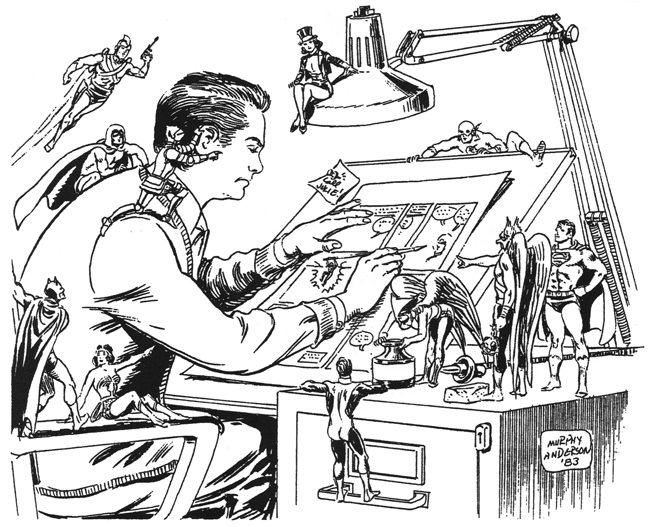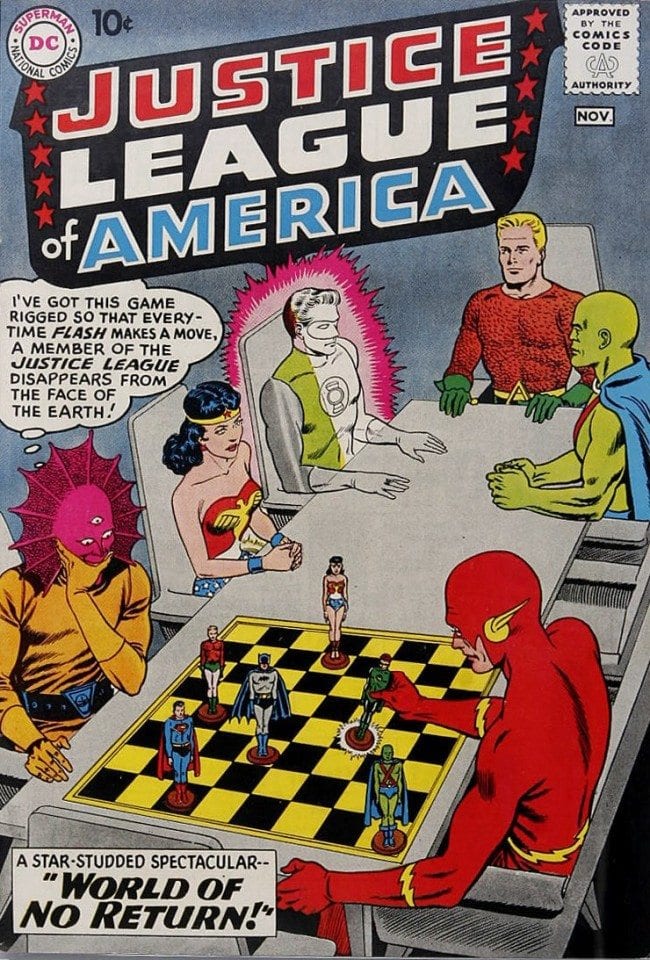 Murphy Anderson, whose artwork spanned the Golden, Silver and Bronze ages of comics, has passed away. He was 89.
Murphy Anderson, whose artwork spanned the Golden, Silver and Bronze ages of comics, has passed away. He was 89.
Anderson was born July 9, 1926 in Asheville, North Carolina. When he was in grade school, his family moved to Greensboro, North Carolina. He grew up reading the comic strips Alley Oop, Captain Easy, The Phantom, and Mandrake, then became fascinated with the science fictional Buck Rogers and Flash Gordon strips. A budding artist, Anderson studied the book How to Draw Cartoons by Claire Briggs, and was soon creating his own characters, usually with a science fiction bent. When comic books came along, he became a fan of the work of Lou Fine, whose finely wrought, expressive figures made him the first superstar of the new medium.
After graduating from high school in 1943, Anderson attended the University of North Carolina briefly, then went to New York to find work in the comics book industry He ended up being hired by Jack Byrne to work in the in-house art staff at Fiction House, publisher of popular titles Jumbo, Planet, Wings, Fight, et al. He worked alongside, and learned from, artists such as Bob Lubbers, Ruben Moriera, and Art Saaf. He particularly admired the work of Reed Crandall and named the Blackhawk artist as an influence. Anderson’s best known regular feature at Fiction House was Star Pirate, which he did from Planet Comics #33 to #51. To improve his knowledge of human anatomy, he took life drawing classes at the Art Students League. At this time, he both penciled and inked his comic book assignments.
Anderson served in the US Navy from 1944 to 1945, when he continued working in comics and drawing for SF pulps while in his stateside postings. In 1947, at age twenty, he became the artist of the Buck Rogers daily comic strip. He continued on the feature for a little over two years, but the pay wasn’t good, so he quit to work for Ziff-Davis where Jerry Siegel had just been hired as an editor of a line of science fiction comic books. By 1951, Anderson had found an advocate in the person of DC editor Julius Schwartz. Anderson’s first stories for DC appeared in Mystery in Space #2 (“The Comet Peril”) and Strange Adventures #9 (“The Exile of Space”). He became the regular artist on Captain Comet from #12 to #44.
 He returned to the Buck Rogers newspaper strip in 1958, but just one year later, he was back knocking on Schwartz’s door at DC. In 1959, however, Schwartz had a full complement of pencilers (Carmine Infantino, Gil Kane, and Mike Sekowsky among them) so Anderson worked more often as an inker. He had a hand in designing the costume of Adam Strange, and became the regular inker of the Infantino-penciled feature from 1960 to 1964. During that time, he was a utility inker deployed by Schwartz to ink covers and complete issues of Green Lantern, Justice League of America, and The Flash. Anderson inked Gil Kane’s pencils for the entirety of the Atom’s first fourteen issues, both in Showcase and his own magazine. He was selected to both pencil and ink the covers of Justice League of America #1 through 4. Anderson was a “heavy” inker whose penciling style was somewhat discernible when he inked others, a “humanistic” style that early members of comics fandom applauded. As a result, he won the five Alley Awards (an early fan award) every year from 1961 through 1965.
He returned to the Buck Rogers newspaper strip in 1958, but just one year later, he was back knocking on Schwartz’s door at DC. In 1959, however, Schwartz had a full complement of pencilers (Carmine Infantino, Gil Kane, and Mike Sekowsky among them) so Anderson worked more often as an inker. He had a hand in designing the costume of Adam Strange, and became the regular inker of the Infantino-penciled feature from 1960 to 1964. During that time, he was a utility inker deployed by Schwartz to ink covers and complete issues of Green Lantern, Justice League of America, and The Flash. Anderson inked Gil Kane’s pencils for the entirety of the Atom’s first fourteen issues, both in Showcase and his own magazine. He was selected to both pencil and ink the covers of Justice League of America #1 through 4. Anderson was a “heavy” inker whose penciling style was somewhat discernible when he inked others, a “humanistic” style that early members of comics fandom applauded. As a result, he won the five Alley Awards (an early fan award) every year from 1961 through 1965.

Anderson was able to return to regular penciling with the Atomic Knights in Strange Adventures from #117 (June 1960) and every third issue thereafter through #160, and with Hawkman in Mystery in Space beginning with #87 (November 1963). He then became the artist on the Hawkman comic book in 1964, and handled revival issues of such Justice Society of America heroes as Dr. Fate and the Spectre in Showcase, and Starman and Black Canary in The Brave and the Bold. With Gardner Fox, he was the co-creator of Zatanna who debuted in Hawkman #4 (October-November 1964).

 In 1966, convinced that the future of comic books was uncertain, Anderson took a job working for Will Eisner’s American Visuals doing artwork for Post Script magazine, an educational magazine for the military. But he was back at DC in 1968 where he stayed until 1973, becoming a regular inker on Curt Swan’s pencils on Superman. The popular Swan-Anderson team was dubbed “Swanderson” by fans. He inked Swan’s pencils for the seminal “Kryptonite No More” series, written by Dennis O’Neil, beginning in Superman #233 (January 1971). Later that year, Anderson was tapped by Gloria Steinem to draw the cover for the first Ms. magazine (actually, an insert in New York magazine, December 1971).
In 1966, convinced that the future of comic books was uncertain, Anderson took a job working for Will Eisner’s American Visuals doing artwork for Post Script magazine, an educational magazine for the military. But he was back at DC in 1968 where he stayed until 1973, becoming a regular inker on Curt Swan’s pencils on Superman. The popular Swan-Anderson team was dubbed “Swanderson” by fans. He inked Swan’s pencils for the seminal “Kryptonite No More” series, written by Dennis O’Neil, beginning in Superman #233 (January 1971). Later that year, Anderson was tapped by Gloria Steinem to draw the cover for the first Ms. magazine (actually, an insert in New York magazine, December 1971).
 In addition to his penciling and inking, Murphy Anderson was inadvertently responsible for an industry-wide change to the size that artists drew comic book original art, going from 12” by 18” to 10” by 15.” The smaller size allowed the publishers to save money in their engraving costs, and became the standard going forward. Drawing smaller meant artists could generally work a little faster, because they had less paper to fill with drawing. Eagle-eyed readers noticed the change, especially in the work of certain artists (such as Jack Kirby) whose work became noticeably less detailed because of the more compact drawing dimensions. Eventually, the artists adapted, and found ways to compensate for anything lost in the change.
In addition to his penciling and inking, Murphy Anderson was inadvertently responsible for an industry-wide change to the size that artists drew comic book original art, going from 12” by 18” to 10” by 15.” The smaller size allowed the publishers to save money in their engraving costs, and became the standard going forward. Drawing smaller meant artists could generally work a little faster, because they had less paper to fill with drawing. Eagle-eyed readers noticed the change, especially in the work of certain artists (such as Jack Kirby) whose work became noticeably less detailed because of the more compact drawing dimensions. Eventually, the artists adapted, and found ways to compensate for anything lost in the change.
For the last phase of his career, Anderson left DC when he won the military contract to produce Post Script magazine. He and his staff produced the magazine from 1973 to 1983. After that, he freelanced, then retired, becoming an occasional guest of comic book conventions until recent years. He was inducted into the Jack Kirby Hall of Fame in 1998 and the Will Eisner Hall of Fame in 1999.
Murphy Anderson will be remembered as a thoroughly professional comics artist who made his mark on virtually all of the top DC characters during his multi-decade tenure with the publisher. He was a hard-working, meticulous craftsman and true gentleman. He will be missed.






